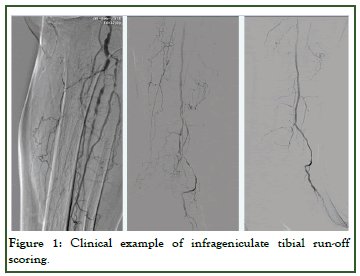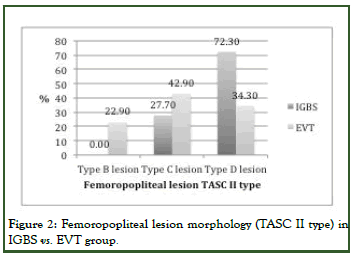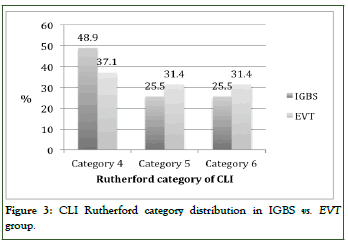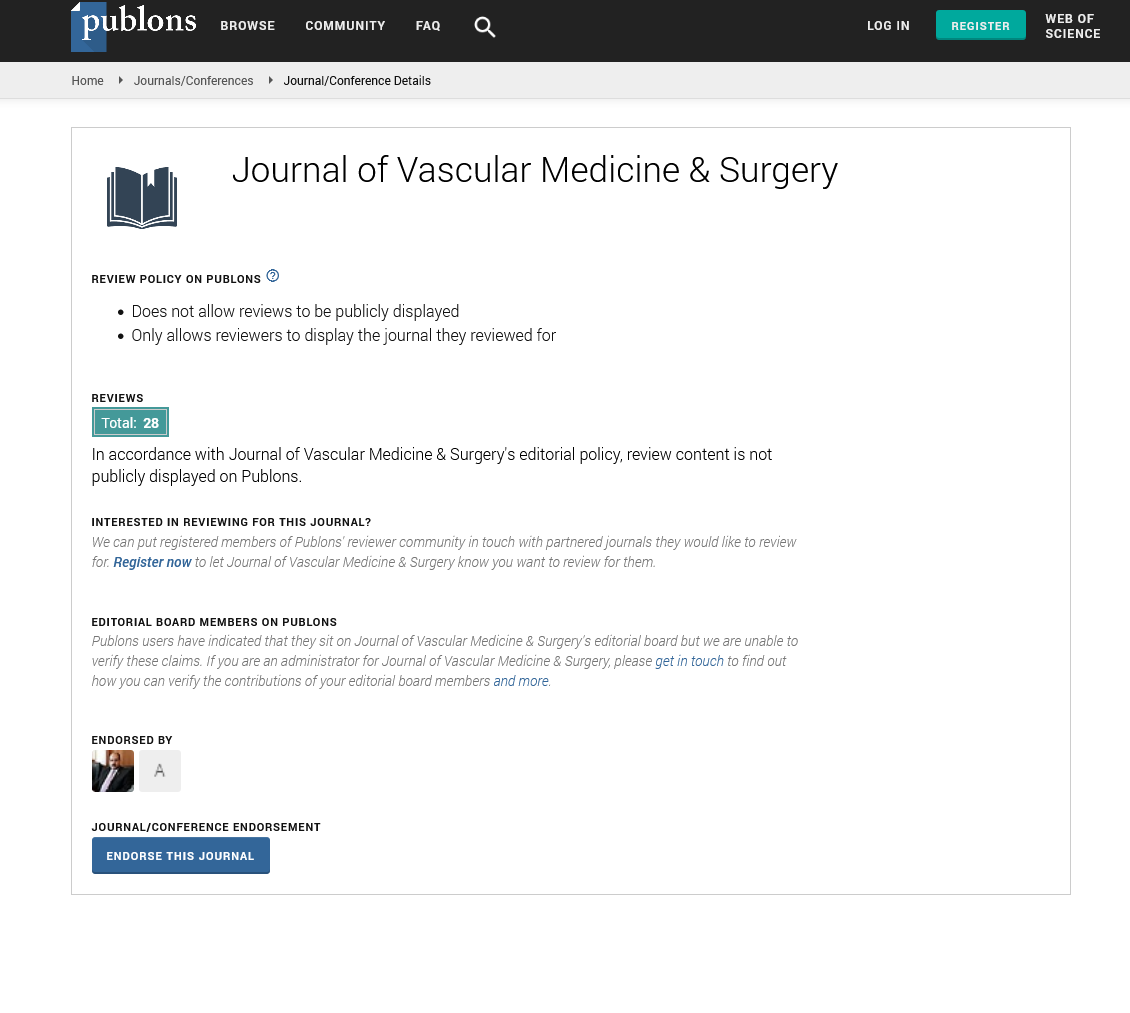Indexed In
- Open J Gate
- Academic Keys
- RefSeek
- Hamdard University
- EBSCO A-Z
- OCLC- WorldCat
- Publons
- Euro Pub
- Google Scholar
- SHERPA ROMEO
Useful Links
Share This Page
Journal Flyer

Open Access Journals
- Agri and Aquaculture
- Biochemistry
- Bioinformatics & Systems Biology
- Business & Management
- Chemistry
- Clinical Sciences
- Engineering
- Food & Nutrition
- General Science
- Genetics & Molecular Biology
- Immunology & Microbiology
- Medical Sciences
- Neuroscience & Psychology
- Nursing & Health Care
- Pharmaceutical Sciences
Research Article - (2024) Volume 12, Issue 5
The Association between Infrageniculate Run-off Score and Selection of Revascularization Method in Patients with Critical Limb Ischemia and Long Segment Lesion of Popliteal Artery
Aina Kratovska1,3*, Sanita Ponomarjova1,4, Lilian Tzivian3 and Patricija Ivanova1,2,32Department of Vascular Surgery, Riga East University Hospital, Riga, Latvia
3Department of Medicine, University of Latvia, Riga, Latvia
4Department of Medicine, Riga Stradins University, Riga, Latvia
Received: 07-Sep-2020, Manuscript No. JVMS-20-6393; Editor assigned: 10-Sep-2020, Pre QC No. JVMS-20-6393 (PQ); Reviewed: 24-Sep-2020, QC No. JVMS-20-6393; Revised: 02-Sep-2024, Manuscript No. JVMS-20-6393 (R); Published: 30-Sep-2024, DOI: 10.35248/2329-6925.24.12.569
Abstract
Background: Quantitative infrageniculate run-off scoring is not highlighted by guidelines of Critical Limb Ischemia (CLI) management. Although not strictly declared, infrageniculate run-off plays an important role in revascularization method (open versus endovascular) selection.
Aim: The aim of this study was to test the infrageniculate run-off scoring system proposed by authors and its association with the selection of the revascularization method in CLI patients with long femoropopliteal lesions involving popliteal artery P1-P2 segment.
Materials and methods: Forty-seven patients with Infrageniculate Bypass Surgery (IGBS) and 36 with Endovascular Therapy (EVT) of long femoropopliteal segment were enrolled into single centre case-control study. Long atherosclerotic lesion of popliteal artery P1-P2 segment was mandatory inclusion criteria. Infrageniculate run-off scoring system proposed by authors (total occlusion=0 point, intact=22) was used to analyze infrageniculate artery status. Age, gender, place of patients’ residence, Rutherford category, femoropopliteal lesion TASC II type, infrageniculate run-off score and the association of variables with revascularization method choice were analyzed.
Results: In IGBS and EVT group mean total infrageniculate run-off score was 15.36 ± 3.99 and 9.51 ± 5.73, respectively. Multiple logistic regression analysis showed that infrageniculate run-off score and femoropopliteal lesion TASCII type has a strong association with revascularization method choice (p<0.001, OR 0.491, 95% CI:0.337-0.714 and p<0.001, OR 0.091, 95% CI:0.026-0.322 respectively).
Conclusion: Study results show that infrageniculate run-off score is a strong predictor of revascularization modality choice in patients with CLI and long femoropopliteal lesion. An authors proposed scoring system was successfully tested for quantitative preoperative assessment of infrageniculate run-off.
Keywords
Critical limb ischemia; Infrageniculate arteries; Tibial arteries; infrageniculate run-off score; Endovascular treatment; Infrageniculate bypass surgery
Introduction
Critical Limb Ischemia (CLI) is a limb and life-threatening condition with a yearly incidence of around 220 new cases per million population. Infrainguinal arterial occlusive disease, with or without concomitant inflow restriction, is a leading source of CLI. In the absence of successful revascularization, up to 40% of patients will require limb amputation and the annual mortality rates exceed 20%. Patient selection bias for Endovascular Treatment (EVT) versus bypass surgery has been disclosed in femoropopliteal.
The Trans-Atlantic Inter-Society Consensus document on management of peripheral arterial disease (TASC) B to D lesions. Both bypass surgery and endovascular therapy can be offered to patients with infrainguinal peripheral arterial disease and CLI [1]. Disagreement exists as to which therapy works best in candidates suitable for both types of intervention. Such factors as a complexity and a length of femoropopliteal lesion, availability of autologous conduit and general medical condition of patient usually plays the first role in treatment modality selection. Bypass surgery is commonly reserved for complex, extensive lesions and patients with expected overall survival >2 years, but endovascular-first strategy is suggested for those patients with limited life expectancy and worse general medical condition.
Treatment methods of long and complex atherosclerotic lesions in P1-P2 segment of popliteal artery have always been a highly discussed topic. In everyday practice the hemodynamic run-off status of infrageniculate arteries (popliteal artery P3 segment and tibial arteries) plays very important role in revascularization method selection for this problematic patient group. But in contradiction to daily life and empiric habits of vascular specialists, current guidelines do not highlight the role of infrageniculate run-off status in revascularization method selection for patients with long femoropopliteal lesions involving P1-P2 segment of popliteal artery.
TASC II guidelines focus on femoropopliteal atherosclerotic lesions, but also do not highlight the role of infrageniculate run-off status impact on treatment selection. Only few studies have disputed, whether the number of infrageniculate run-off arteries have an impact on infrainguinal angioplasty or bypass patency rates as well as treatment modality selection, therefore supporting the importance of this study.
To our knowledge, a simple scoring system, in the same time rather fully reflecting the severity of the disease, exclusively designed for infrageniculate run-off evaluation before Infrageniculate Bypass Surgery (IGBS) or EVT, is not widely represented in up-to date literature. The aim of this study was to apply and to test a scoring system proposed by authors, in particular evaluation of infrageniculate run-off status and to analyse its association with revascularization method selection (EVT vs. IGBS) in patients with CLI and hemodynamically significant atherosclerotic lesions in long femoropopliteal segment involving popliteal artery P1-P2 segment.
Materials and Methods
Research design and patient selection
A case-control study was conducted by review of medical records in single center tertiary care hospital between January, 2016 and December, 2016. One hundred and five patients were initially involved into study [2]. Following inclusion criteria were applied:
• Critical limb ischemia
• Americam Society of Anaesthesiologists (ASA) score II.
Preoperative general medical condition of patients was
evaluated by anesthesiologist and patients with ASA score II
were selected for the study, thus general health condition in
both study groups was equal.
• TASCII classification type B-D femoropopliteal lesion.
Preoperative imaging was performed by either Digital
Subtraction Angiography (DSA) or Computed Tomography
Angiography (CTA). Foot had to be fully included into CTA
and DSA series for pedal arch evaluation.
• Multiple hemodynamically significant stenoses >75% or
occlusion of popliteal artery P1-P2 segment with total lesion
length >8 cm.
• IGBS with distal anastomosis on popliteal artery P3 segment
(group 1) or EVT in the area of popliteal artery with stenting
(group 2).
In all patients EVT or IGBS was assigned in respect to multidisciplinary team treatment choice decision. In open surgery group, only patients with primary IGBS and distal anastomosis on popliteal artery P3 segment were included. Patients assigned to secondary IGBS due to failed primary bypass surgery or failed endovascular treatment were excluded from the study (n=20).
In EVT group, only patients with primary intervention in the area of popliteal artery were selected. The mandatory inclusion criterion was stenting of popliteal artery P1-P2 segment with or without stent extension to femoral artery and popliteal artery P3 segment. For EVT of popliteal artery only dedicated intervowen self-expanding nitinol stent was used. Patients with endovascular reintervention of popliteal artery target lesion were excluded from study (n=2).
General characteristics of patients
The following personal characteristics of patients were assessed: Age, gender, place of residence (rural area, regional town or capital). Medical characteristics of patients included the Rutherford category of CLI (category 4, 5 or 6), the femoropopliteal lesion severity assessed according to TASC II classification (type B, C or D) and the modality of preoperative diagnostic imaging (CTA or DSA).
Infrageniculate run-off scoring
For objective quantification of infrageniculate run-off status, new scoring system was created and proposed by authors (Table 1). For every patient involved in the study, an infrageniculate run-off score was calculated by certified interventional and diagnostic radiologist according to preoperative DSA or CTA data. Following major arteries, downstream to popliteal artery P2 segment were analyzed: Popliteal artery P3 segment (aPOP P3), Anterior Tibial Artery (ATA), Tibioperoneal Trunk (Tr.TP), Posterior Tibial Artery (ATP), Peroneal Artery (aPer) and integrity of anterior pedal arch. Status of vessels mentioned above was characterized and scored as occlusion of vessel, occlusion with distal flow restoration through collaterals, hemodynamically significant stenosis (>50% of lumen) hemodynamically insignificant stenosis (<50% of lumen) or completely intact artery [3]. Pedal arch was characterized as intact, disrupted or occluded. Disrupted pedal arch was represented as multiple hemodynamically significant stenoses or short occlusions with flow restoration through collaterals. In both groups infrageniculate run-off score was calculated according to the formulas:
• Total infrageniculate run-off score=aPOP P3+ATA+Tr.TP
+ATP+aPer+pedal arch.
• Tibial run-off score=ATA+Tr.TP+ATP+aPer.
• Infrageniculate run-off score=P3+ATA+Tr.TP+ATP+aPer.
Pedal arch score was excluded in following calculations,
because this variable after univariate analysis was proven to be
with no statistically significant difference in both groups.
| Infrageniculate artery (points) | ||||||
| P3 | ATA | Tr. TP | ATP | aPer | Pedal arch | |
|---|---|---|---|---|---|---|
| Total occlusion | 0 | 0 | 0 | 0 | 0 | 0 |
| Occlusion with distal flow restoration through collaterals | 0.5 | 0.5 | 0.5 | 0.5 | Disrupted arch | |
| Hemodynamically significant stenosis (>50%) | 2 | 1 | 1 | 1 | 1 | 0.5 |
| Hemodynamically non-significant stenosis | 5 | 3 | 3 | 3 | 2 | |
| Intact | 6 | 4 | 4 | 4 | 3 | 1 |
Note: P3-Popliteal artery P3 segment (infrageniculate popliteal artery); ATA-anterior tibial artery; Tr.TP-Tibioperoneal trunk; ATP-Posterior Tibial Artery; aPer-Peroneal artery
Table 1: Calculation scheme of infra geniculate run-off score (min=0, max=22 points).
Statistical analysis
Descriptive statistics was performed separately for every study group for following independent variables: Age (years), gender, location of residence (rural area, regional town, capital city), CLI Rutherford category (category 4, 5 or 6), femoropopliteal lesion TASC II type (B, C, D), infrageniculate and tibial run-off score. Groups were compared for these variables using t-test for continuous variables and chi-square test (exact Fisher test) for categorical variables. Difference score of TASC II lesion types between groups was tested using a one-way ANOVA test. Multiple logistic regression analysis for association between revascularization method choice and infrageniculate/tibial runoff score (adjustments: Age, gender, location of residence, Rutherford category, TASC II lesion type) was performed.
P values<0.05 were considered statistically significant [4]. Statistical analysis was performed by SPSS 22 program.
Results
Forty-seven patients in IGBS group and 36 patients in EVT group met all of the inclusion criteria and were incorporated into study. Mean patient age was higher in EVT group than in IGBS group: 74.03 ± 8.96 vs. 68.87 ± 8.22, p=0.01. There was a statistically significantly higher tendency for male to undergo IGBS, but for female there was higher tendency towards EVT (Exact Fisher test, p=0.03) (Table 2).
| Revascularization method | Significance of differences (p) | ||
|---|---|---|---|
| IGBS | EVT | ||
| Cases (n) | 47 | 35 | |
| Age (years) | |||
| Mean, ± SD, min-max | 68.87 ± 8.22 | 74.03 ± 8.96 | 0.008 |
| 56-86 | 55-94 | ||
| Gender | |||
| Male/Female (n (%)) | 30 (63.8)/17 (36.2) | 14 (40)/21 (60) | 0.032 |
| Location of residence (%) | |||
| Capital | 29.8 | 45.7 | 0.235 |
| Regional town | 21.3 | 22.9 | |
| Rural area | 48.9 | 31.4 | |
| Preoperative imaging (%) | |||
| DSA | 78.7 | 74.3 | 0.451 |
| CTA | 21.3 | 25.7 | |
| Rutherford category preoperatively (%) | |||
| 4 | 48.9 | 37.1 | 0.582 |
| 5 | 25.5 | 31.4 | |
| 6 | 25.5 | 31.4 | |
| Femoropopliteal lesion TASC II type (%) | |||
| B | 0 | 22.8 | 0.006 |
| C | 27.7 | 42.9 | |
| D | 72.3 | 34.3 | |
Table 2: Descriptive analysis of study population.
We found slightly higher tendency for patients from rural area to undergo IGBS and for patients from capital to undergo EVT, but this association was statistically non-significant (chi-square test, p=0.23).
In most of the cases the main preoperative diagnostic method was DSA: IGBS 78.7% vs. EVT 74.3% with no statistically significant difference in both groups (p=0.45).
In EVT group most frequent lesion was TASCII type C, but in IGBS group- type D, representing more severe lesion morphology undergoing surgery; the difference between groups was statistically significant (Pearson chi-square test, p<0.01) [5]. TASC II type of femoropopliteal leasion did not had statistically significant association neither with age (One-way ANOVA, p=0.913), nor with gender (Pearson chi-square test, p=0.15). Univariate analysis showed statistically significant difference between groups of revascularization method for femoropopliteal lesion TASC II type (Pearson chi-square test, p<0.01) (Figures 1 and 2).

Figure 1: Clinical example of infrageniculate tibial run-off scoring.

Figure 2: Femoropopliteal lesion morphology (TASC II type) in IGBS vs. EVT group.
All cases based on medical records were split into clinical severity categories of CLI according to Rutherford classification. In both groups category 4 (rest pain) was the most frequently recorded. In EVT, a slightly higher tendency for clinically more severe stages (category 5 and 6) was observed, but the difference between groups was not statistically significant (Pearson chi-square test, p=0.58). The univariate analysis did not show statistically significant association between Rutherford category and revascularization method choice (Pearson chi-square, p=0.57) (Figure 3).

Figure 3: CLI Rutherford category distribution in IGBS vs. EVT group.
Preoperative aPOP P3+tibial run-off, separate tibial run-off score, pedal arch run-off score and total infrageniculate run-off score (aPOP P3+tibial+pedal arch) were calculated in points according to scoring system proposed in the study. In IGBS group vs. EVT group mean aPOP P3+tibial run-off score was 14.75 ± 3.98 vs. 8.93 ± 5.70 points, mean tibial run-off score was 9.07 ± 3.88 vs. 5.70 ± 3.85 points, mean pedal arch score 0.54 ± 0.26 vs. 0.58 ± 0.28 points, mean total infrageniculate run-off score 15.36 ± 3.99 vs. 9.51 ± 5.73 points (Table 3) [6].
| Revascularization method | Infrageniculate run-off score P3+ATA+Tr.TP+ATP+aPer | Tibial run-off score ATA+Tr.TP+ATP+aPer | Pedal arch score | Total infrageniculate run-off score P3+ATA+Tr.TP+ATP+aPer+pedal arch |
|---|---|---|---|---|
| Infrageniculate bypass (n=47) | ||||
| Mean | 14.755 | 9.074 | 0.545 | 15.366 |
| Median | 15 | 10 | 0.5 | 15.5 |
| Mode | 17 | 11 | 0.5 | 17.5 |
| Std.Deviation | 3.976 | 3.887 | 0.26 | 3.987 |
| Min | 6 | 1.5 | 0 | 6.5 |
| Max | 21 | 15 | 1 | 22 |
| Endovascular revascularization (n=36) | ||||
| Mean | 8.928 | 5.7 | 0.586 | 9.514 |
| Median | 9 | 5.5 | 0.5 | 9.5 |
| Mode | 14 | 1 | 0.5 | 14.5 |
| Std.Deviation | 5.702 | 3.852 | 0.284 | 5.727 |
| Min | 0.5 | 0.5 | 0 | 0.5 |
| Max | 21 | 15 | 1 | 22 |
Table 3: Infrageniculate run-off score in IGBS vs. EVT group
In univariate analysis the association between aPOP P3+tibial run-off score and separate tibial run-off score with revascularization method choice was proven to be statistically significant (for preoperative infrageniculate run off score/ revascularization method t=3.90, p<0.01; for preoperative tibial run-off score/revascularization method t=5.180, p<0.01) [7]. Results disclose that patients with less severe changes in infrageniculate arteries are selected for open surgery, but patients with worse infrageniculate run-off status are more frequently reserved for endovascular therapy.
Pedal arch in IGBS vs. EVT group was totally occluded in 9.1% vs. 8.6%, deficient in 72.7% vs. 65.7% and intact in 18.2% vs. 25.7%. Pedal arch score was not statistically significantly different between both treatment groups (Pearson chisquare= 0.66, p=0.72), therefore this variable was excluded from further multiple logistic regression analysis.
Age significantly negatively correlated with preoperative infrageniculate run-off score (Pearson correlation, p<0.01). Thus, higher age was associated with worse infrageniculate run-off. There were no significant gender differences in respect to infrageniculate run-off score [8]. Rutherford category had statistically significant negative correlation with tibial run-off score (p=0.02) and weak statistical correlation with infrageniculate run-off score (p=0.05). Femoropopliteal lesion TASC II type did not had statistically significant correlation with tibial run-off/infrageniculate run-off score (p=0.99), therefore it is independent predictor of revascularization modality choice as it was shown by univariate analysis.
Irrespective to univariate analysis data, age, gender, location of patient’s residence and Rutherford category in multiple logistic regression analysis didn’t showed statistically significant association with revascularization method choice. Infrageniculate run-off score and tibial run-off score in multiple logistic regression analysis showed very strong association with revascularization method choice (OR=0.49, 95% CI: 0.34-0.71 and OR=1.69, 95% CI: 1.09-2.60, respectively) [9]. Another variable that showed strong statistically significant association with revascularization method choice in multivariate analysis was femoropopliteal lesion TASC II type (OR=0.91, 95% CI: 0.03-0.32) (Table 4).
| Variable | B | S.E | Wald | Df | Sig. | Exp(B) | 95% CI for Exp (B) | |
|---|---|---|---|---|---|---|---|---|
| Lower | Upper | |||||||
| Age | 0.005 | 0.047 | 0.014 | 1 | 0.907 | 1.005 | 0.917 | 1.103 |
| Gender | -0.912 | 0.821 | 1.234 | 1 | 0.267 | 0.402 | 0.08 | 2.008 |
| Location of residence | 0.018 | 0.459 | 0.002 | 1 | 0.968 | 1.019 | 0.415 | 2.503 |
| Rutherford category | 0.309 | 0.525 | 0.347 | 1 | 0.556 | 1.362 | 0.487 | 3.808 |
| TASC II lesion type | -2.396 | 0.644 | 13.841 | 1 | 0 | 0.091 | 0.026 | 0.322 |
| Infrageniculate run-off score | -0.712 | 0.191 | 13.853 | 1 | 0 | 0.491 | 0.337 | 0.714 |
| Tibial run-off score | 0.523 | 0.221 | 5.591 | 1 | 0.018 | 1.687 | 1.094 | 2.603 |
Table 4: Multivariate analysis of associations with revascularization modality.
Discussion
Study results approve that infrageniculate run-off score along with femoropopliteal lesion TASC II type are strong predictors of revascularization modality choice in patients with CLI and long femoropopliteal lesion involving P1-P2 segment of popliteal artery. No perfect scheme for run-off grading has been created. Several angiographic and run-off scoring systems have been developed and proposed. To estimate peripheral run-off from preoperative angiographies, the revised SVS/ISCVS Ad-Hoc scoring system could be recommended for patients undergoing bypass surgery, because this system grades the condition of the recipient vessel.
Nevertheless, complete SVS/ISCVS scoring system with "weighting units" is rather complicated. It was designed for general estimation of run-off for bypasses with different distal anastomosis levels. Whereas simplified four-level run-off grade offers too robust evaluation, especially if used for patients with infrageniculate disease undergoing endovascular recanalization. Hiramori et al. has offered run-off scoring system (grade 0 to 2) based on antegrade flow speed beyond a point below the knee, but it can be applied only for post endovascular therapy angiographical evaluation.
Wu et al. showed differences in some usually applied scores. For example, when using the simplified SVS run-off score for grading peripheral arterial disease, there was excellent correlation among readers, but it is rather robust in description of vascular status [10]. When using TASC II class to grade lesions, there was a greater degree of variation when compared with the simplified SVS run-off scoring. Finally, there was poor correlation between readers when using the complete SVS run-off score. To our opinion some changes have to be performed to fulfill lacks in currently existing systems.
We propose that popliteal artery should be outlined from general description of femoropopliteal segment; nevertheless, the current TASC II guidelines do not offer the possibility of doing that. All segments of popliteal artery are equally included into common characterization of femoropopliteal segment according to currently existing guidelines.
The updated infrapopliteal vascular territory TASC II classification is regarded as anatomic description of the lesion patterns to enable comparison between various grades of lesion complexity, but as it is stated in guidelines, they are not sufficient on their own to guide clinical decisions regarding revascularization treatment strategy. In everyday clinical practice, evaluating patients before open surgery or endovascular revascularization, in respect to infrageniculate and tibial run-off, we found a difficulty of using both classification/scoring systems mentioned above for infrageniculate segment.
For example, patients with circular ischemic ulcer on distal crural area who have an occlusion of only posterior tibial artery, cannot be classified according to updated infrapopliteal TASC II classification, because the target vessel in this case cannot be stated. An updated TASC II infrapopliteal classification also cannot be applied in patients with Rutherford category 4 CLI, because in these patients the target vessel cannot be selected due to absence of ischemic tissue loss [11]. Therefore, we saw a necessity for a new runoff scoring system designed exclusively for infrageniculate segment as it is proposed in this study.
According to the results of our study, younger male were more prone to be selected for IGBS. This finding is consistent with current TASC II guidelines, which recommend selection of open surgery as treatment modality in patients with long femoropopliteal lesions and life expectancy >2 years. Female were more prone to be selected for EVT. Literature reveals disparity of gender and treatment selection of Peripheral Arterial Disease (PAD).
Several authors have reported more advanced disease of PAD at the time of diagnosis or treatment among women and that female have higher tendency for complications both in open surgery and in EVT groups.
In this study TASC II type of femoropopliteal lesion has been shown as independent and strong predicting factor of revascularization modality choice. It was also shown that patients with TASC II type D lesions were more frequently selected for surgery, which is consistent with current guidelines. Controversy to guidelines, patients with TASC II type C and D lesions were selected for EVT, although guidelines recommend open surgery for these cases. That can be explained by the fact that patients with equal TASC II type lesion might have completely different lesion anatomy representing imperfection of TASC II classification, which does not highlight the popliteal artery it self.
For example, patient with long femoral occlusion extending into popliteal artery P1-P2 segment will be classified as type D and most probably treated with bypass surgery. On the contrary, patient with occlusion of popliteal artery from P1- P3 segment with involvement of trifurcation will also be classified as type D lesion, but in case of poor run-off will most likely be reserved for EVT and not for surgery. Therefore infrageniculate run-off plays an important role in treatment modality choice for patients with equal TASC II type femoropopliteal lesion.
In this study it was also found that pedal arch was deficient in most of the cases both in EVT and IGBS group and there was no statistically significant difference of pedal arch scores between groups. This finding could be partially explained by angiography technique-longer exposition at the level of foot probably could unmask more detailed vascular anatomy, because visualization of retrograde filling of deficient pedal arch takes longer fluoroscopy time in DSA or delayed scanning in CTA.
Longer exposition during DSA at the level of foot could turn some patients defined as having “total occlusion” of pedal arch into “deficient pedal arch”, but some patients defined as having “deficient pedal arch” could be classified as “intact arch”, which was hidden due to longer filling in patients with upstream occlusion of tibial arteries. The other reason for non-different pedal arch score in both groups could be too robust scoring [12]. Probably more detailed score should be applied to reveal full vascular anatomy of foot, but again it will render scoring more complicated.
In this study it was found that patients with worse infrageniculate run-off score are more frequently selected for EVT as the only feasible treatment modality. This finding raises the question whether poor infrageniculate runoff affects the patency rates of long popliteal stents and impairs the outcomes in comparison to bypass surgery, where run-off is better.
Literature reveals a discrepancy: Whether tibial run-off has an impact on bypass surgery or EVT patency rates and therefore should it be ever taken into account before treatment method selection? For example, in Hiramori et al. it was found that runoff grade seems to play an important role to keep the primary patency after EVT. Davie et al. also showed that in patients presenting with CLI who are treated with EVT in superficial femoral artery, patency is negatively affected by compromised and poor run-off. Whereas in Lee et al. study it was found that there was no difference in the primary patency of stented segments with two or three patent tibial arteries and those with one or no vessels continuous to the ankle, thus the number of patent tibial vessels did not influence the primary patency of primarily stented femoral and popliteal arteries. The same discrepancy can be found regarding run-off status and bypass surgery patency rates. Heise et al. study showed that the angiographic run-off did not correlate with peripheral resistance, impedance or patency rates for patients undergoing bypass surgery. Whereas Karacagil et al. group showed that one of the crucial factors affecting the outcome of femoro-distal bypass surgery is the quality of the distal vascular run-off. Current study has to be continued to disclose the impact of infrageniculate runoff on treatment patency rates.
The results of this study have revealed a strong association between calculated run-off score and treatment modality selection of CLI, therefore we believe this scoring system could be applied in everyday practice. Further study has to be conducted to test whether application of “angiosomal coefficient” (adding additional points of significance for the target tibial artery, which vascularizes the angiosome with ischemic tissue loss) could improve the proposed scoring system.
Conclusion
Study results show that infrageniculate run-off score along with femoropopliteal lesion TASC II type are strong predictors of revascularization modality choice in patients with CLI and long femoropopliteal lesion involving P1-P2 segment of popliteal artery. Therefore objective quantitative preoperative run-off scoring could be recommended in a routine practice. The scoring system proposed by authors has been successfully tested for simplified quantitative infrageniculate run-off evaluation both before bypass surgery and EVT.
References
- van Overhagen H, Spiliopoulos S, Tsetis D. Below-the-knee interventions. Cardiovasc Intervent Radiol. 2013;36:302-311.
[Crossref] [Google Scholar] [PubMed]
- Farber A, Rosenfield K, Menard M. The BEST-CLI trial: A multidisciplinary effort to assess which therapy is best for patients with critical limb ischemia. Tech Vasc Interv Radiol. 2014;17(3):221-224.
[Crossref] [Google Scholar] [PubMed]
- Jaff MR, White CJ, Hiatt WR, Fowkes GR, Dormandy J, Razavi M, et al. An update on methods for revascularization and expansion of the TASC lesion classification to include below-the-knee arteries: A supplement to the inter-society consensus for the management of peripheral arterial disease (TASC II). J Endovasc Ther. 2015;22(5):663-677.
[Crossref] [Google Scholar] [PubMed]
- Antoniou GA, Chalmers N, Georgiadis GS, Lazarides MK, Antoniou SA, Serracino-Inglott F, et al. A meta-analysis of endovascular versus surgical reconstruction of femoropopliteal arterial disease. J Vasc Surg. 2013;57(1):242-253.
[Crossref] [Google Scholar] [PubMed]
- Lee JJ, Katz SG. The number of patent tibial vessels does not influence primary patency after nitinol stenting of the femoral and popliteal arteries. J Vasc Surg. 2012;55(4):994-1000.
[Crossref] [Google Scholar] [PubMed]
- Heise M, Kruger U, Ruckert R, Rad F, Scholz H, Neuhaus P, et al. Correlation between angiographic runoff and intraoperative hydraulic impedance with regard to graft patency. Ann Vasc Surg. 2003;17(5):509-515.
[Crossref] [Google Scholar] [PubMed]
- Acin F, Varela C, Lopez de Maturana I, de Haro J, Bleda S, Rodriguez-Padilla J. Results of infrapopliteal endovascular procedures performed in diabetic patients with critical limb ischemia and tissue loss from the perspective of an angiosome‐oriented revascularization strategy. Int J Vasc Med. 2014;2014(1):270539.
[Crossref] [Google Scholar] [PubMed]
- Hiramori S, Soga Y, Tomoi Y, Tosaka A. Impact of runoff grade after endovascular therapy for femoropopliteal lesions. J Vasc Surg. 2014;59(3):720-727.
[Crossref] [Google Scholar] [PubMed]
- Pulli R, Dorigo W, Pratesi G, Fargion A, Angiletta D, Pratesi C. Gender-related outcomes in the endovascular treatment of infrainguinal arterial obstructive disease. J Vasc Surg. 2012;55(1):105-112.
[Crossref] [Google Scholar] [PubMed]
- Belkin M, Conte MS, Donaidson MC, Mannick JA, Whittemore AD. The impact of gender on the results of arterial bypass with in situ greater saphenous vein. Am J Surg. 1995;170(2):97-102.
[Crossref] [Google Scholar] [PubMed]
- Jackson EA, Munir K, Schreiber T, Rubin JR, Cuff R, Gallagher KA, et al. Impact of sex on morbidity and mortality rates after lower extremity interventions for peripheral arterial disease: Observations from the blue cross blue shield of Michigan cardiovascular consortium. J Am Coll Cardiol. 2014;63(23):2525-2530.
[Crossref] [Google Scholar] [PubMed]
- Beard JD. Which is the best revascularization for critical limb ischemia: Endovascular or open surgery? J Vasc Surg. 2008;48(6):11S-16S.
[Crossref] [Google Scholar] [PubMed]
Citation: Kratovska A, Ponomarjova S, Tzivian L, Ivanova P (2024) The Association between Infrageniculate Run-off Score and Selection of Revascularization Method in Patients with Critical Limb Ischemia and Long Segment Lesion of Popliteal Artery. J Vasc Surg. 12:569.
Copyright: © 2024 Kratovska A, et al. This is an open-access article distributed under the terms of the Creative Commons Attribution License, which permits unrestricted use, distribution, and reproduction in any medium, provided the original author and source are credited.

